2004 VOLKSWAGEN GOLF PLUS coolant temperature
[x] Cancel search: coolant temperaturePage 228 of 541
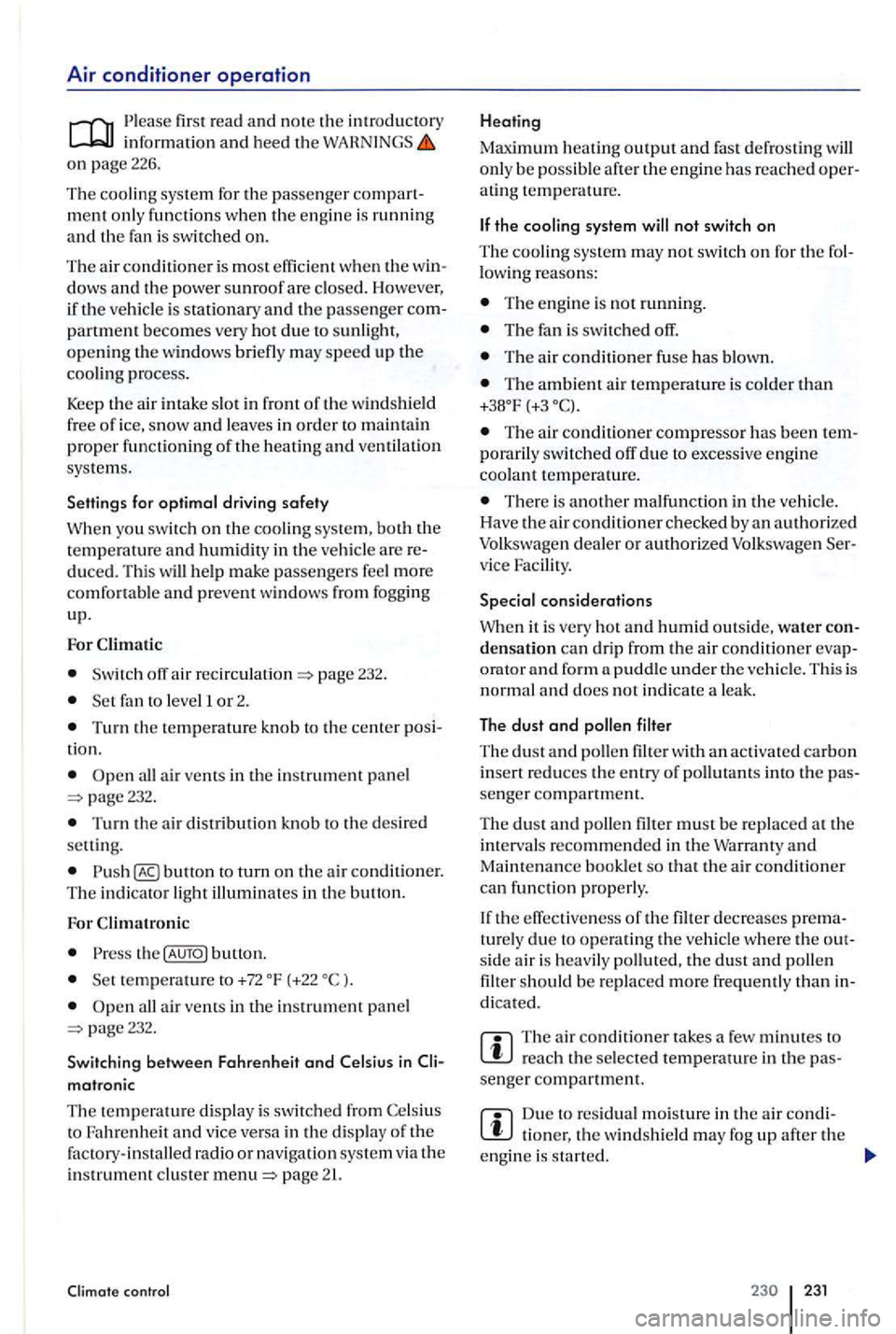
Air conditioner operation
information and heed the WAHNINGS on page 226.
The cooling syste m for the passenger compart
ment o nl y functions when the engin e is running
and the fan is switched on.
The air conditioner is most efficient when the w indows an d the power sunroof are closed. However,
if th e vehicle is sta ti o nary and the passenger compartment becomes very hot due to sunlight, opening the w indows briefly may speed up the cooling proce ss.
Keep
the a ir intake slot in front of the windshield
free of i ce, snow and lea ves in order to maintain proper funct ioning of the heating and ventilation systems.
Settings for optimal driving safety
When yo u sw itch on the cooling system, both the temperature and humidity in the vehicle are reduced. Th is will help make passengers feel more comfo rtable and prevent windows from fogging
up.
For
Sw itch off a ir page 232.
fan to Ievell or 2.
T urn the temperature knob to t he center posi
tion.
all air vents in the in strument panel page232 .
Turn the air distribution knob to the des ired settin g.
butto n to turn on the air conditioner. The indicator light illumin ate s in the button.
For
th e button.
temperature to +72
pa ge232.
Sw itching between Fahrenheit and Celsius in Cli
matronic
The t empe ratu re disp lay is switched from to Fahrenheit and vice versa in the display of the factory- in stalled radio or naviga tion system via the in strument cluster page
control
H eating
Maximum heating output and fas t defrosting will
only be possib le a fte r the e ngin e has reached operating tempe rature.
T he e ng in e is not running.
T he fan is switc hed off.
The a ir conditi one r fuse has blown.
The ambien t a ir temperature is colder than (+3
T he air condition er compresso r has been tem
porarily switched off due to excess ive engin e coolant temperature.
The re is a nother malfunction in the ve hicle.
Ha ve the ai r conditioner checked by an authorize d
Volkswage n dealer or authorized Volkswage n Ser
v ice Facility.
Special considerations
Whe n it is very hot and humid outside, water con
d ensation can drip from the air condition er evaporator and form
The air condit ioner takes a few minutes to reach the selected temperature in the passenger compartment.
Due to residual m oisture in the air condi tione r, th e windshi eld may fog up after the
engi ne is s tarted.
23 1
Page 240 of 541
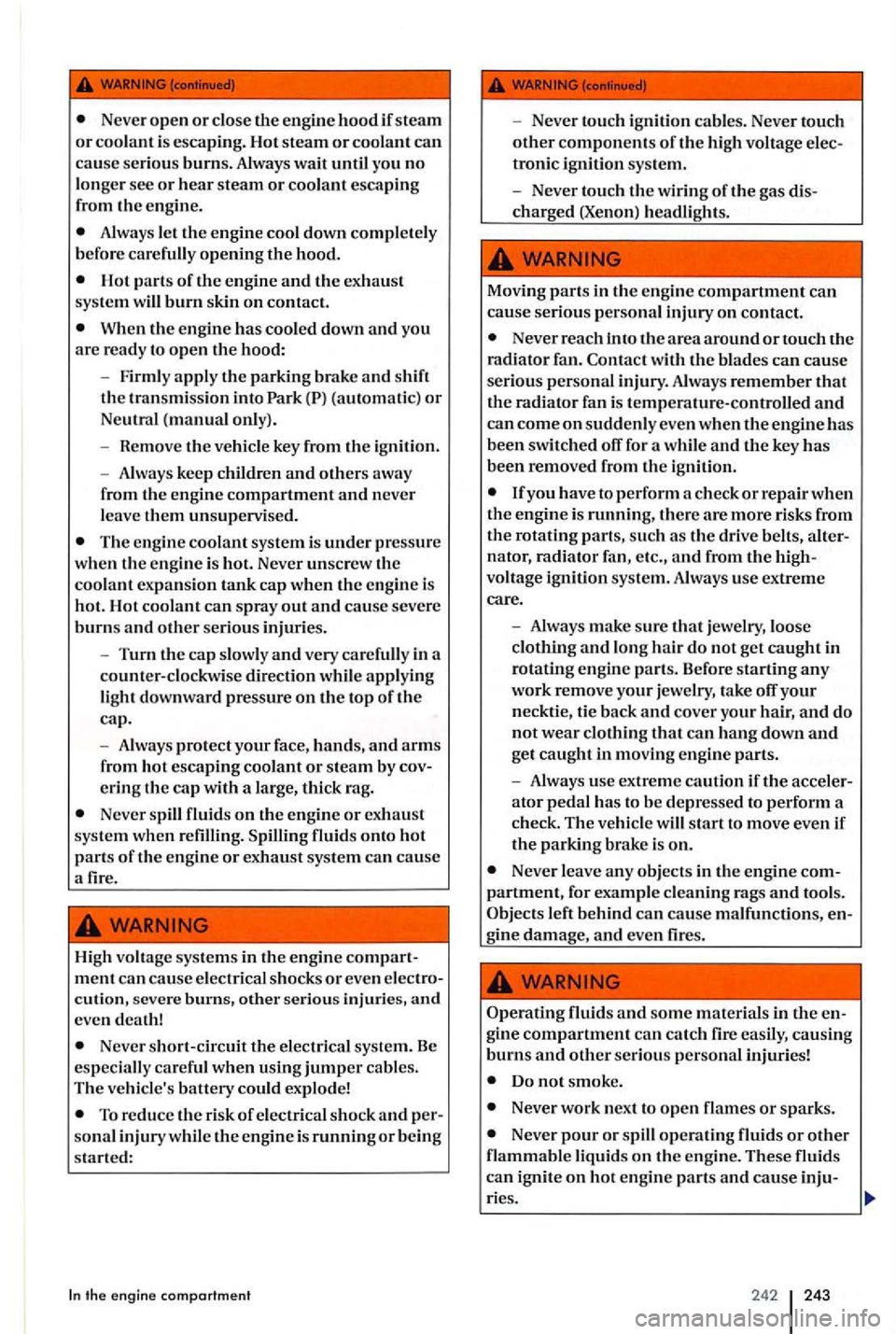
Never open or close the engine hood if steam or coolant is escaping. Hot steam or coolant can cause serious burns. Always wait until you no longer sec or hear steam or coolant escaping
from the engine.
Hot parts of the engine and the exhaust
system will burn skin on contact.
When the engine has cooled down and you are ready to open the hood:
- Firmly
apply the parking brake and shift the transmission into Park
The engine coolant system is under pressure when the engine is hot. Never unscrew the coolant expansion tank cap when the engine is
hot. Hot coolant can spray out and cause severe burns and other serious injuries.
- Turn
the cap slow ly and very carefully in a
counter-clockwise direction while applying
light downward pressure on the top of the cap.
- A
lways protect your face, hands, and arms from hot escaping coolant or steam by
Never spill fluids on the engine or exhaust
system when Spilling fluids onto hot parts of the engine or exhaust system can cause a fire.
High voltage systems in the
engine com ment can cause electrical shocks or even
Never short-circuit the electrical system. Be especially careful when using jumper cables. The vehicle's battery could explode!
To reduce the risk of electrical shock and sonal injury while the engine is running or being started:
the engine compartment
- Never touch ignition cables. Never touch other components of the high voltage tronic ignition system.
- Never touch
the wiring of the gas
Never reach into t11e area around or touch the
radia tor fan. Contact with the blades can cause serious personal injury. Always remember that the radiator fan is temperature-controlled and can come on suddenly even when the engine has been switched for a while and the key has been removed from the ignition.
lfyou have to perform a check or repair when the engi ne is running, there are more risks from tl1e rotating parts, such as the drive belts, nator, radiator fan, etc ., and from voltage ignition system. Always use extreme care.
- Always make
sure that jewelry, loose clothing and long hair do not get caught in rotating engine parts. Before starting any work remove your je welry, take
parking brake is on.
Never leave any objects in the engine
left behind can cause malfunctions,
Do not smoke.
Never work next to open flames or sparks.
Never pour or spill operating fluids or other flammable liquids on the engine. These fluids can ignite on hot en g in e parts and cause ries .
242 243
Page 249 of 541
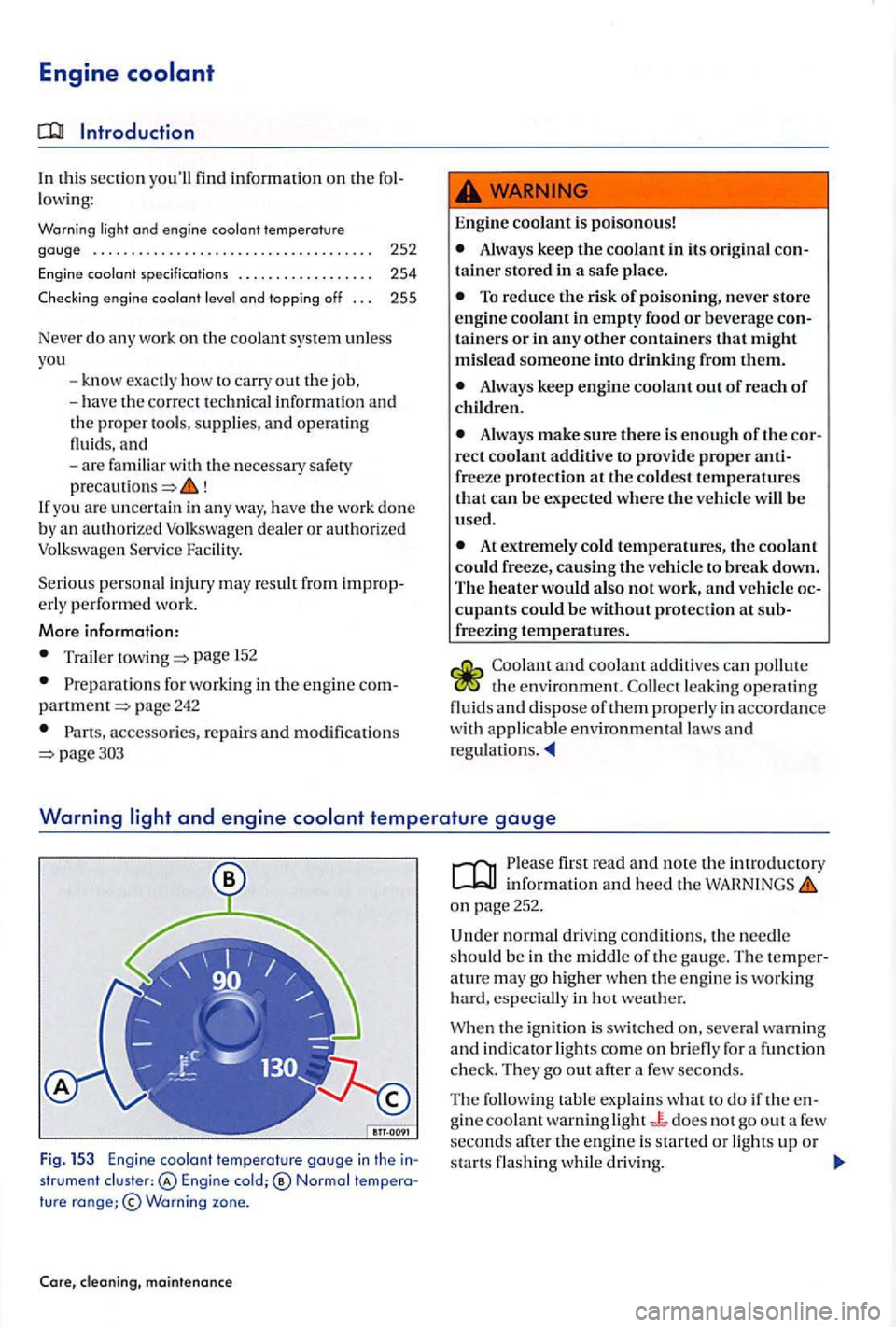
Engine coo la nt
Introduction
In thi s section you'll find informat ion on the following:
Warning
engine coolant and topping off . . . 255
Never do a ny wor k on the coo lant system unless
you
-know exactly ho w to carry out the job,
-have the correct tec hnical informa tion and
th e proper to ols, supplie s, and operating
fluid s, a nd
-are familiar with the necessary safet y
pr eca utions
Traile r page 152
fo r work ing in the e ngine compartment page 242
Part s, acce ssories , re pair s and modification s
Engin e coo lant is poisonous!
Always keep the coolant in its origi nal con
t ainer stored in a safe place .
To reduce the risk of poisoning, never store engine coolant in empty food or beverag e containers or in any other containers that might mislead someone into drinking from them.
Always keep engine coolant out of reach of c hildr en.
Alway s make sure there is enough of tJ1e cor
re ct coo lant additive to provid e proper anti
fr eeze protection at the cold es t temperatures that can be expected where the vehicle will be used .
At extremely cold temperatures, the coolant could freeze, causing the vehicle to break down.
The heater would also not work, and vehicle oc
cupants could be without protection at subfreezing temperatures.
leaking operat ing
fluids and dispose of t h e m properly in acco rdance
w ith applicable environmental laws and regulat ion s .
Warning light and engine coolant temperature gauge
Fig . 153 E ngine coolant temperature gauge in the instr umen t Engi ne cold;® Normal temperature range;© Warn ing zone.
Core, maintenance
first read and note th e introduct ory information and heed th e on page 252.
normal driving conditi ons, th e needle
s h o uld be in the middl e of th e ga uge. The temper
ature may go high er w hen th e e ngine is w orking
h ard, espec iall y in hut
When the igni tion is sw itch ed on , seve ra l warnin g and indicator light s co me o n bri efly fo r a function
c h ec k. The y go our after a few seconds.
Th e fo
llow ing table explains w ha t t o do if th e en
gine coolant warn ing does no t go out a few secon ds after the engine is s tart ed or light s up or
s tart s fla sh ing while driving.
Page 250 of 541
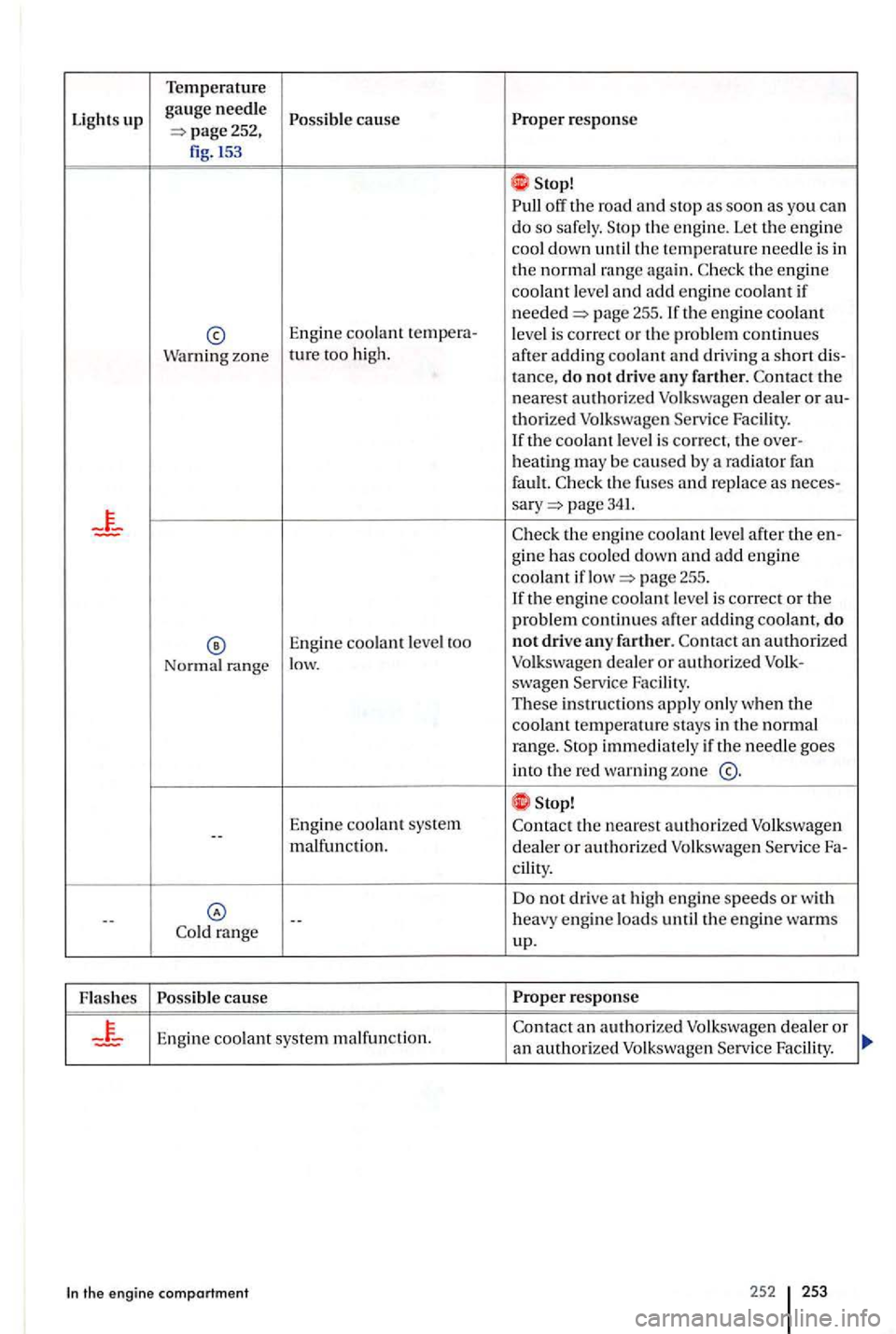
Temperature
Lights up gauge needle response page252,
fig . 153
off the road and s top as soon as you can do so safely.
the engin e
coolant l eve l and add e ngine coolant if page 255. th e e ngin e coo lant E ng in e coolant tempera-
leve l is correc t o r the p roble m continues Warning zone l
u re too high. afte r addin g coo la nt and driv ing a sh ort tance, do not drive an y farther.
sary 341.
th e engin e coo la nt level after the en-
gine has coole d d own and add en gine
coolant i f page 255. the engine coo la nt leve l is correc t or tl1e problem continues after adding coolant, do
En gin e coolant leve l too not drive a ny farther.
Facility.
These in struction s apply only when the coolant temperature stays in the normal
rang e. immediately if the needle goes
in to
the red warning zone
Eng ine coo lant system the nearest authorized Volk swagen .. malfunction. dealer or authorized Volkswage n
Do not drive at hi gh en g in e s peeds or with heavy en g in e loads until the engine warm s
cause
Engi ne coo lant syste m malfun ction .
the engine compartment 252 253
Page 251 of 541
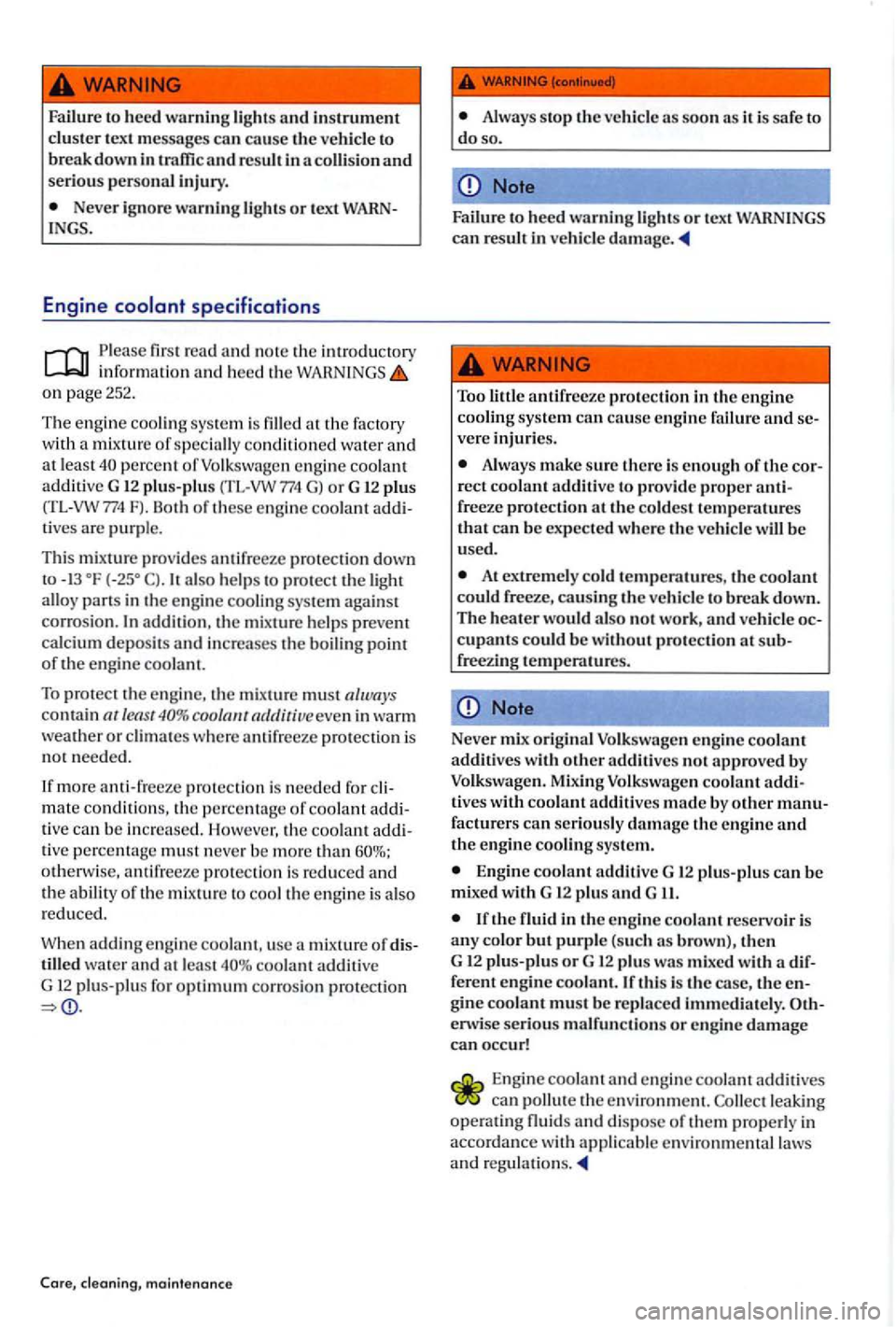
Failure to heed warnin g light s and instrument cluster text message s can cause the ve hicl e to break down in traffic and result in a and seriou s personal injury .
Never ignore warning light s or text I NGS.
Engine coolant specifications
introdu ctory information and heed th e on pag e 252.
The engi ne c ooling sys tem is fille d
p erce nt of Volk s wa gen engi ne coo lant additi ve G 12 plu s-plu s (TL-VW 774 G) o r G 12 plus (TL -VW F). Both of these engin e coola nt ti ve s are purple.
This mixtur e pro vides antif r eeze pro te ction down
to -13 a ls o he lps to pro tec t th e light
allo y pan s in th e eng in e coolin g sys te m against
corro sio n. In addit ion, the mi xture help s preve nt
c alcium dep os its and in creases the bo ilin g point of the e ng in e coola nt.
T o
protec t th e e ng in e, the mi xture must a lway s co nt ain nt le a st
mate conditions , th e perc entage of coola nt ti ve can be in cre ased. Howe ver, the coo la nt ti ve pe rc e n ta ge mu st never be m ore than oth erw ise , ant ifreeze prot ection is reduce d a nd
th e ability of the mi xture to coo l th e e ngine is als o
r educed.
Whe n addin g e ngine coolant, use a mixture of till ed water and at l ea st c o o la nt addit ive G 12 plu s- plu s for optimum co rro sion protection
Core, maintenanc e
Always stop the vehicl e as soon as it is saf e to do so.
Note
Failure to heed warning lights o r text can re s ult in veh icle damage.
Too little antifreeze protection in the en gin e coolin g syste m can cause eng in e failure and vere injuri es.
be used.
At extremely cold temperatures, the coolant could freeze, cau sin g the v ehicl e to brea k down. The heater would als o no t work, and ve hicl e cupants could be without protection at free zing temperatures.
Note
N eve r mix original Volkswagen engine coo lant additives with other additi ve s no t approved by
Volkswagen. Mixing Volkswage n coo la nt
facturers can serio usly damage th e engine and th e engi ne coolin g sys te m .
Eng in e coolant additive G 12 plus-plus can b e
m ixed with G 12 plus and G
If the fluid in th e e ngine coo lant res ervoir is any color but purple (s u ch
this is th e case, the gin e coolant mus t b e r epla ced immedi ate ly . envi se serious m alfun ction s or engine damage can occ ur!
E ng in e coolan t a nd engine c oo lant additi ves can pollute th e environm ent. le akin g opera ting a nd disp ose of th em in
acco rdance with appli cable e nvir o nm ent al la ws
a nd
Page 370 of 541

Water under vehicle . . . . . . . . . . . . . . . . . 231
Wipers ............................. 129
S peed rating code le tter ................. 293
Stalling
Protecting th e ve hicle ................
S teering ...............................
Cou nter- steering support ............
E lectro-mechanical. . . . . . . . . . . . . . . . . .
Indicator light. ......................
to one side ................... 286 Servo steering .......................
Steering co lumn lock .... ............
Steering wheel
A dju sti
ng . . . . . . . . . . . . . . . . . . . . . . . . . . . . 63 S hift paddles (Ti ptron ic) . . . . . . . . . . . . . 185
Sticke rs . . . . . . . . . . . . . . . . . . . . . . . . . . . . . . . 311
Storage areas . . . . . . . . . . . . . . . . . . . . . . . . . .
storage compartments . . . . . . . . . 165
Overhead console . . . . . . . . . . . . . . . . . . . 161
manual. . . . . . . . . . . . . . . . . . . . . 16 3
Pa sse nge r sid e . . . . . . . . . . . . . . . . . . . . . . 16 3 Storage compartment light . . . . . . . . . . . 125
Stow ing luggage . . . . . . . . . . . . . . . . . . . . . . . 13 8
protection. . . . . . . . . . . . . . . . . . . . . . . . . 126
brak e sys tem (ABS) . . . . . . . . . 194
Regulation . . . . . . . . . . . . . . . . . 196
194
Launch control program . . . . . . . . . . . . . 186
Assis t . . . . . . . . . . . . . . . . . . . . . . . . . .
Distance Control. . . . . . . . . . . . . . . .
Rear Assist . . . . . . . . . . . . . . . . . . . . . . . . . .
C urb weight. . . . . . . . . . . . . . . . . . . . . . . . .
Dimensions. . . . . . . . . . . . . . . . . . . . . . . . . . 33
Displacement . . . . . . . . . . . . . . . . . . . . . . . . 32 E ngin e data an d dimensions . . . . . . . . . . 32
Engine oil specifications . . . . . . . . . . . . . 248
Filling capacity. . . . . . . . . . . . . . . . . . . . . . 132
Fu el capacities . . . . . . . . . . . . . . . . . . . . . . 237 Gross vehicle we ight. . . . . . . . . . . . . . . . .
.............................. 32
Roof load . . . . . . . . . . . . . . . . . . . . . . . . . . . 15 1
Sa fety Compliance Certif ic ation Label. . 3 1
Tir e pressure . . . . . . . . . . . . . . . 283 Tongue load . . . . . . . . . . . . . . . . . . . . . . . . 152 Weights . . . . . . . . . . . . . . . . . . . . . . . . . . . .
Technical modifica tions . . . . . . . . . . . . . . . .
temperature . . . . . . . . . . . . . . . . . . 17
Temperature gauge
E n gin e coolant . . . . . . . . . . . . . . . . . . . . . . 252
hooks........................ 146
T ighteni ng torque Whee l bo lts . . . . . . . . . . . . . . . . . . . . . . . . . 332
372 373